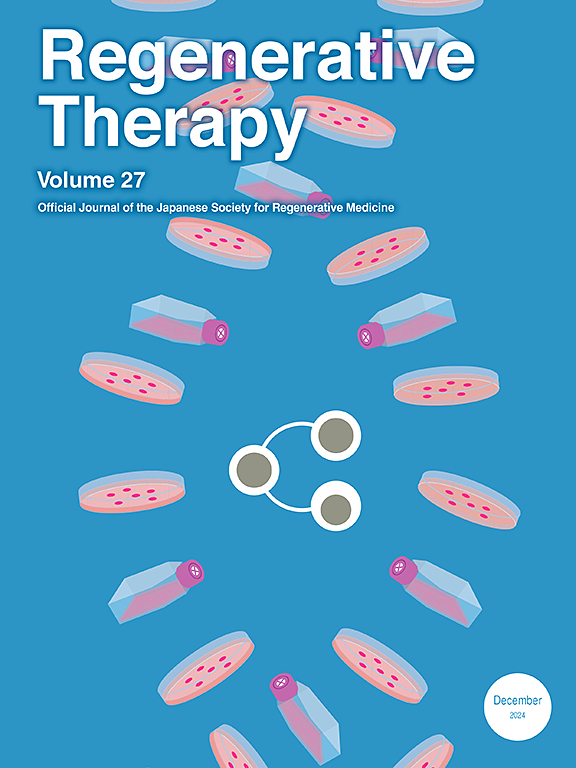婴儿骨髓间充质干细胞与脐带间充质干细胞在多系分化中的比较
IF 3.4
3区 环境科学与生态学
Q3 CELL & TISSUE ENGINEERING
引用次数: 0
摘要
我们通过评估多线分化,比较了婴儿骨髓间充质干细胞(BMSCs)和脐带间充质干细胞(UCSCs)。增殖通过细胞数量和倍增时间的变化来衡量。衰老相关基因(p16、p21和p53)、衰老相关β-半乳糖苷酶(SA-β-gal)和γH2AX免疫荧光确定衰老的存在。使用逆转录-定量聚合酶链反应(RT-qPCR)分析了超氧化物歧化酶(SOD)和与各种分化相关的基因。通过组织化学、免疫组织化学和免疫荧光染色确认了分化情况。婴儿 BMSCs 的增殖能力超过了 UCSCs。婴儿 BMSCs 在晚期表现出较低的衰老相关基因表达,早期抗氧化酶上调,SA-β-gal 染色减少。婴儿 BMSCs 的软骨基因表达(SOX9、COL2 和 COL10)增强,免疫组化染色也有所改善。组织化学染色证实,婴儿 BMSCs 的成骨(ALP 和 OCN)和成脂(PPARγ 和 LPL)基因表达较高。然而,UCSCs 的成腱基因(MMP3、SCX、DCN 和 TNC)表达量更高。致肝分化潜力相似,致肝基因表达(ALB 和 TAT)无显著差异。与 UCSCs 相比,婴儿 BMSCs 表现出更高的增殖性、更低的衰老性、更强的抗氧化能力以及向软骨、成骨和成脂系分化的潜力。本文章由计算机程序翻译,如有差异,请以英文原文为准。
Comparison of infant bone marrow- and umbilical cord-derived mesenchymal stem cells in multilineage differentiation
We compared infant bone marrow-derived mesenchymal stem cells (infant BMSCs) with umbilical cord-derived mesenchymal stem cells (UCSCs) by assessing multilineage differentiation. Proliferation was gauged through changes in cell numbers and doubling time. Senescence-related genes (p16, p21, and p53), senescence-associated β-galactosidase (SA-β-gal), and γH2AX immunofluorescence determined senescence presence. Superoxide dismutases (SODs) and genes related to various differentiations were analyzed using reverse transcription-quantitative polymerase chain reaction (RT-qPCR). Differentiation was confirmed through histochemical, immunohistochemical, and immunofluorescence staining. Infant BMSCs surpassed UCSCs in proliferation. Infant BMSCs exhibited lower senescence-related gene expression at late passages, upregulated antioxidant enzymes during early passages, and reduced SA-β-gal staining. Chondrogenic gene expression (SOX9, COL2, and COL10) was enhanced in infant BMSCs, along with improved immunohistochemical staining. Infant BMSCs showed higher expression of osteogenic (ALP and OCN) and adipogenic (PPARγ and LPL) genes, confirmed by histochemical staining. However, UCSCs had higher expression of tenogenic genes (MMP3, SCX, DCN, and TNC). Hepatogenic differentiation potential was similar, with no significant difference in hepatogenic gene expression (ALB and TAT). Compared to UCSCs, infant BMSCs demonstrated superior proliferation, reduced senescence, increased antioxidant capacity, and enhanced differentiation potential toward chondrogenic, osteogenic, and adipogenic lineages.
求助全文
通过发布文献求助,成功后即可免费获取论文全文。
去求助
来源期刊

Regenerative Therapy
Engineering-Biomedical Engineering
CiteScore
6.00
自引率
2.30%
发文量
106
审稿时长
49 days
期刊介绍:
Regenerative Therapy is the official peer-reviewed online journal of the Japanese Society for Regenerative Medicine.
Regenerative Therapy is a multidisciplinary journal that publishes original articles and reviews of basic research, clinical translation, industrial development, and regulatory issues focusing on stem cell biology, tissue engineering, and regenerative medicine.
 求助内容:
求助内容: 应助结果提醒方式:
应助结果提醒方式:


